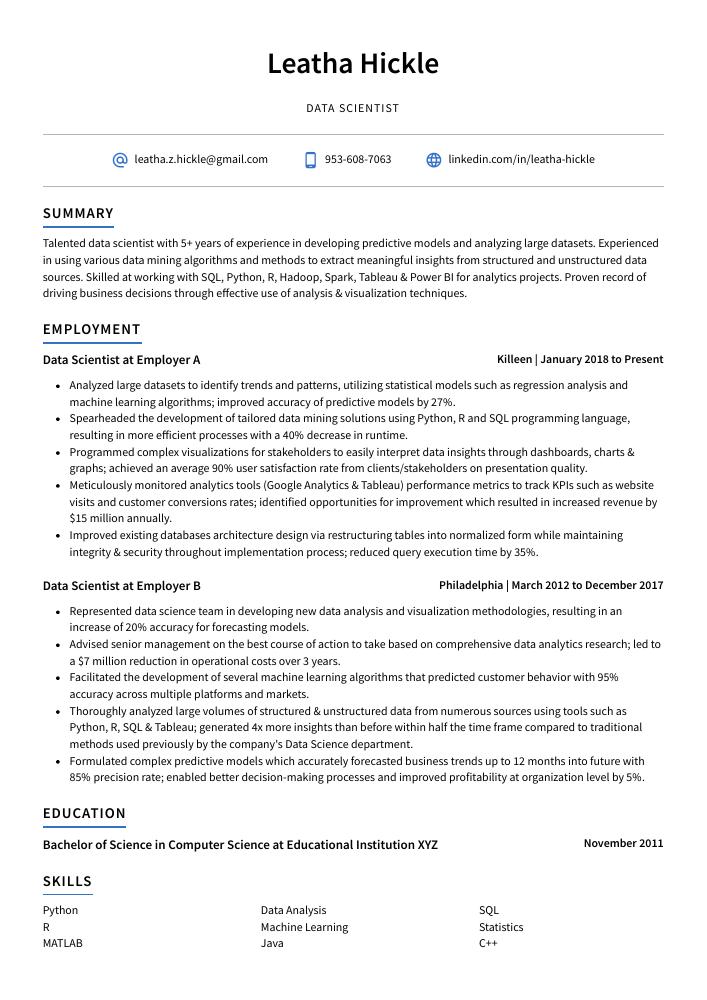Data Scientist Resume Guide
Data scientists analyze and interpret large amounts of data to uncover trends, develop insights, and drive business decisions. They use a variety of analytical tools such as machine learning algorithms and statistical methods to identify patterns in the data. Furthermore, they create visualizations that help communicate their findings effectively while leveraging their technical expertise to build automated solutions for complex problems.
You have an amazing knack for analytics and data-driven decision making. But employers don’t know how great you are at it yet, so to get their attention, you must craft a resume that highlights your talents and achievements in the field of data science.
This guide will walk you through the entire process of creating a top-notch resume. We first show you a complete example and then break down what each resume section should look like.
Table of Contents
The guide is divided into sections for your convenience. You can read it from beginning to end or use the table of contents below to jump to a specific part.
Data Scientist Resume Sample
Leatha Hickle
Data Scientist
[email protected]
953-608-7063
linkedin.com/in/leatha-hickle
Summary
Talented data scientist with 5+ years of experience in developing predictive models and analyzing large datasets. Experienced in using various data mining algorithms and methods to extract meaningful insights from structured and unstructured data sources. Skilled at working with SQL, Python, R, Hadoop, Spark, Tableau & Power BI for analytics projects. Proven record of driving business decisions through effective use of analysis & visualization techniques.
Experience
Data Scientist, Employer A
Killeen, Jan 2018 – Present
- Analyzed large datasets to identify trends and patterns, utilizing statistical models such as regression analysis and machine learning algorithms; improved accuracy of predictive models by 27%.
- Spearheaded the development of tailored data mining solutions using Python, R and SQL programming language, resulting in more efficient processes with a 40% decrease in runtime.
- Programmed complex visualizations for stakeholders to easily interpret data insights through dashboards, charts & graphs; achieved an average 90% user satisfaction rate from clients/stakeholders on presentation quality.
- Meticulously monitored analytics tools (Google Analytics & Tableau) performance metrics to track KPIs such as website visits and customer conversions rates; identified opportunities for improvement which resulted in increased revenue by $15 million annually.
- Improved existing databases architecture design via restructuring tables into normalized form while maintaining integrity & security throughout implementation process; reduced query execution time by 35%.
Data Scientist, Employer B
Philadelphia, Mar 2012 – Dec 2017
- Represented data science team in developing new data analysis and visualization methodologies, resulting in an increase of 20% accuracy for forecasting models.
- Advised senior management on the best course of action to take based on comprehensive data analytics research; led to a $7 million reduction in operational costs over 3 years.
- Facilitated the development of several machine learning algorithms that predicted customer behavior with 95% accuracy across multiple platforms and markets.
- Thoroughly analyzed large volumes of structured & unstructured data from numerous sources using tools such as Python, R, SQL & Tableau; generated 4x more insights than before within half the time frame compared to traditional methods used previously by the company’s Data Science department.
- Formulated complex predictive models which accurately forecasted business trends up to 12 months into future with 85% precision rate; enabled better decision-making processes and improved profitability at organization level by 5%.
Skills
- Python
- Data Analysis
- SQL
- R
- Machine Learning
- Statistics
- MATLAB
- Java
- C++
Education
Bachelor of Science in Computer Science
Educational Institution XYZ
Nov 2011
Certifications
Certified Analytics Professional
INFORMS
May 2017
1. Summary / Objective
A resume summary/objective is your chance to make a great first impression with the hiring manager. As a data scientist, you should use this section to highlight your technical skills and experience in areas such as machine learning, artificial intelligence, predictive analytics, natural language processing (NLP), and big data technologies. You can also mention any awards or certifications you have received that demonstrate your expertise in these fields. Additionally, if applicable, include how many years of experience you have working with various programming languages like Python or R and frameworks like TensorFlow or PyTorch.
Below are some resume summary examples:
Seasoned and results-driven data scientist with 7+ years of experience leveraging predictive analysis to uncover actionable insights and solve complex business problems. Expertise in Python, R, SQL, Tableau and Excel. Seeking a position at ABC Tech to provide deep analytics support for their innovative products. Recently achieved an 8% reduction in customer churn rate by identifying key drivers using advanced statistical modeling techniques.
Detail-oriented Data Scientist with 5+ years of experience in exploratory data analysis, feature engineering, and predictive modeling. Experienced in using machine learning algorithms to build data-driven solutions for a variety of industries. At XYZ Inc., developed an AI solution that increased customer retention by 23%. Seeking to leverage my knowledge and skills at ABC Company to develop innovative applications for complex datasets.
Hard-working data scientist with 5+ years of experience leveraging data to design and develop predictive models that deliver actionable insights. Skilled in Python, R, SQL, Machine Learning algorithms such as regression analysis and clustering. At XYZ Corporation, developed a model that predicted customer churn rate with an accuracy of 92%. Seeking to join ABC Company where I can use my expertise in data science to drive success.
Well-rounded data scientist with 5+ years of experience in leveraging data to solve complex business problems. Skilled at building predictive models, developing insightful reports and optimizing algorithms. At XYZ Corporation, developed a machine learning system that increased revenue by 15%. Recognized for creating advanced analytics methods that improved customer segmentation strategies resulting in an 8% increase in sales.
Determined data scientist with 5+ years of experience in data analysis, machine learning and predictive modeling. Adept at developing algorithms to optimize business processes while providing insights into customer behaviors and market trends. At ABC Technologies, used advanced analytics techniques to reduce forecasting errors by 20%. Looking for a position that allows me to drive innovation through data-driven solutions.
Proficient data scientist with 7+ years of experience leveraging data-driven insights to develop innovative solutions that improve customer experiences and increase organizational efficiency. Experienced in creating machine learning models, building predictive analytics systems, and designing reports for stakeholders. Seeking a role at ABC Company where I can apply my expertise to drive positive business outcomes.
Energetic and experienced data scientist with 5+ years of experience in predictive modeling and machine learning. Skilled at uncovering actionable insights from large datasets, leveraging technologies such as Python, R, SQL and Hadoop/Spark for data engineering tasks. Proven success in building innovative solutions to challenging problems across multiple industries including finance and healthcare.
Committed data scientist with 5+ years of experience developing models, conducting analysis and constructing predictive analytics. Advanced knowledge in machine learning algorithms, natural language processing (NLP) and data visualization tools such as Tableau. Seeking to leverage expertise at ABC Tech to develop innovative solutions that drive organizational success through data-driven insights.
2. Experience / Employment
In the experience section, you should provide details on your employment history. This should be written in reverse chronological order, meaning that the most recent job is listed first.
When writing out what you did for each role, use bullet points to make it easier for the reader to take in all of the information quickly. You want to include detail and quantifiable results when possible; instead of saying “Analyzed data,” say something like “Utilized Python programming language and SQL queries to analyze 10 million customer records, resulting in a 20% increase in sales.”
To write effective bullet points, begin with a strong verb or adverb. Industry specific verbs to use are:
- Analyzed
- Modeled
- Visualized
- Optimized
- Automated
- Interpreted
- Predicted
- Programmed
- Collected
- Cleaned
- Processed
- Structured
- Developed
- Implemented
- Investigated
Other general verbs you can use are:
- Achieved
- Advised
- Assessed
- Compiled
- Coordinated
- Demonstrated
- Expedited
- Facilitated
- Formulated
- Improved
- Introduced
- Mentored
- Participated
- Prepared
- Presented
- Reduced
- Reorganized
- Represented
- Revised
- Spearheaded
- Streamlined
- Utilized
Below are some example bullet points:
- Presented complex data insights to senior stakeholders and investors, leading to a 20% increase in investment returns over the last quarter.
- Visualized large datasets using Tableau, PowerBI and Excel with an emphasis on accuracy; created interactive dashboards for easy visualization of data trends & patterns that improved decision-making processes by 40%.
- Accurately analyzed customer behavior across various digital channels using SQL queries which resulted in more targeted campaigns yielding 25% higher click-through rates than industry standards.
- Streamlined reporting processes through automation of analytics tasks with Python scripts, reducing manual effort by 50% while improving efficiency and accuracy of results produced.
- Reduced operational costs associated with analyzing big data sets by 75%, creating cost savings of $30K+ per month for the company as a whole.
- Developed predictive models and algorithms to analyze large datasets of customer transactions, resulting in a 23% increase in sales.
- Reorganized complex data sets into usable schemas that enabled easy access for analysis; reduced manual effort by 40%.
- Consistently monitored machine learning model performance, identifying opportunities to improve accuracy and efficiency; achieved an average accuracy score of 95%.
- Revised existing database structure to accommodate new sources of information while maintaining integrity between different databases; improved query speeds by 30%.
- Optimized processes for collecting, cleaning, verifying and transforming data using Python scripting language with SQL queries; increased automation rate by 50%.
- Interpreted and analyzed data from multiple sources (e.g., surveys, experiments, databases) to identify patterns and trends that could be used to drive business decisions; improved predictive accuracy by 15%.
- Utilized advanced statistical models such as regression analysis and machine learning algorithms to develop meaningful insights into customer behavior and preferences; achieved $8M in cost savings over the last year.
- Implemented Tableau dashboards for visualizing large datasets quickly and effectively; reduced time spent on reporting by 50 hours per month.
- Substantially increased efficiency of data mining processes through automation using Python scripting techniques; created automated reports with an 80% reduction in manual labor costs over 2 years’ span.
- Modeled complex relationships between variables within big datasets utilizing Natural Language Processing methods while ensuring high levels of accuracy (+90%) at all times.
- Compiled large datasets from multiple sources and expedited data analysis process by 40%, allowing for efficient insights on business operations.
- Coordinated with stakeholders to develop predictive models that accurately forecasted a 10% increase in revenue over the course of 5 months.
- Resourcefully implemented machine learning algorithms such as regression, decision tree and k-means clustering to identify customer segmentation trends within the market landscape at an 80% accuracy rate.
- Cleaned up messy datasets using Python libraries such as Pandas and NumPy; reduced manual effort in rearranging data points by 65%.
- Developed dashboards for executives that showcased detailed visualizations highlighting key performance indicators (KPIs); enhanced understanding of company metrics by 20%.
- Successfully implemented machine learning algorithms to develop predictive models with an accuracy of 98%, increasing sales by $2.3 million over the last year.
- Structured, prepared and analyzed large datasets from multiple sources using Python, SQL, R and SPSS; identified new trends in customer behavior that resulted in a 20% improvement in marketing campaigns effectiveness.
- Prepared detailed reports for senior management on data mining projects progress, outlining project objectives and results achieved with clear visuals such as charts & graphs; reduced report creation time by 40%.
- Automated regular reporting processes through creating dashboards & scorecards via Tableau & Power BI; improved decision-making capabilities of executives while reducing manual effort required to generate insights by 70%.
- Mentored 3 junior team members on developing advanced analytics skillsets including statistical modeling techniques and supervised their work on 5+ projects involving complex datasets processing tasks; increased team efficiency by 25%.
- Assessed large, complex datasets to identify patterns and trends using advanced statistical techniques such as regression analysis, decision trees and natural language processing; reduced data-related errors by 10%.
- Effectively extracted insights from structured & unstructured data sources with SQL programming languages and created compelling visualizations that enabled stakeholders to make informed decisions.
- Collected, cleaned up, merged & manipulated large volumes of customer transaction records while ensuring accuracy in the results; increased operational efficiency by 15%.
- Participated in multiple projects related to machine learning algorithms development for predictive analytics purposes; delivered cost savings of $50K per quarter on average over a 3 year period.
- Investigated existing databases for any inconsistencies or irregularities in order to produce detailed reports outlining the findings and suggesting solutions accordingly; improved product reliability by 22% within 6 months after implementation of recommendations.
- Achieved a 15% improvement in model accuracy by developing machine learning algorithms and neural networks to process large datasets.
- Processed over 5 million records of data for analysis, utilizing various statistical techniques such as regression & clustering methods to uncover insights from the collected information.
- Predicted customer buying habits with an 80% success rate through rigorous experimentation with different predictive models and validation processes.
- Diligently monitored a wide range of performance metrics on all developed models for continual improvement; reduced error rates by 20%.
- Introduced innovative approaches that yielded cost savings of $50,000 per quarter while improving the speed at which complex analyses could be performed by 30%.
3. Skills
Skill requirements will differ from employer to employer – this can easily be determined via the job advert. Organization ABC may be looking for someone with experience in machine learning, while Organization XYZ may require a data scientist who is proficient in Python.
It is essential to tailor the skills section of your resume to each job you are applying for. This will ensure that applicant tracking systems can easily pick up on the relevant keywords and pass it onto human recruiters.
In addition, you should also discuss some of these skills further in other sections such as work experience or summary statement – this way employers get an idea of how well-versed you are when it comes to certain technologies/programming languages etc.
Below is a list of common skills & terms:
- Algorithms
- Amazon Web Services
- Analysis
- Analytics
- Apache Spark
- Big Data
- Business Analysis
- Business Intelligence
- C
- C#
- C++
- CSS
- Data Analysis
- Data Mining
- Data Modeling
- Data Science
- Data Visualization
- Databases
- Deep Learning
- Economics
- Financial Analysis
- Git
- HTML
- Hadoop
- Java
- JavaScript
- LaTeX
- Linux
- MATLAB
- Machine Learning
- Mathematical Modeling
- Mathematics
- Microsoft SQL Server
- MySQL
- Natural Language Processing
- NumPy
- Pandas
- Physics
- Predictive Analytics
- Predictive Modeling
- Programming
- Python
- R
- SAS
- SAS Programming
- SPSS
- SQL
- Science
- Scikit Learn
- Simulations
- Software Development
- Stata
- Statistical Data Analysis
- Statistical Modeling
- Statistics
- Tableau
- Teaching
- Team Leadership
- Teamwork
- TensorFlow
- Time Management
4. Education
Adding an education section on your resume is dependent on how far along you are in your career. If you recently graduated and have no work experience yet, it’s a good idea to mention your education below the resume objective. However, if you’ve been working as a data scientist for years with plenty of accomplishments to show off, omitting an education section may be best.
If including an education section is necessary or desired, try to list courses and subjects related to the role of data scientist that you studied while pursuing higher learning.
Bachelor of Science in Computer Science
Educational Institution XYZ
Nov 2011
5. Certifications
Certifications are an important part of any resume, as they demonstrate to potential employers that you have the necessary skills and knowledge for a given job. Having certifications in your field shows that you are committed to staying up-to-date with industry trends and best practices.
Including relevant certifications on your resume can help set you apart from other applicants by showing hiring managers that you possess the qualifications needed for the position. Be sure to list all applicable certificates or licenses so recruiters know exactly what kind of expertise you bring to the table.
Certified Analytics Professional
INFORMS
May 2017
6. Contact Info
Your name should be the first thing a reader sees when viewing your resume, so ensure its positioning is prominent. Your phone number should be written in the most commonly used format in your country/city/state, and your email address should be professional.
You can also choose to include a link to your LinkedIn profile, personal website, or other online platforms relevant to your industry.
Finally, name your resume file appropriately to help hiring managers; for Leatha Hickle, this would be Leatha-Hickle-resume.pdf or Leatha-Hickle-resume.docx.
7. Cover Letter
Providing a cover letter with your job application is an important step and can often make the difference between getting a callback or not. It should be written in 2 to 4 paragraphs, focusing on why you are the ideal candidate for the role.
Cover letters give you a chance to explain more about yourself than what’s included in your resume, allowing recruiters to understand who you really are beyond just qualifications and experience. They also provide an opportunity for you to demonstrate your enthusiasm for the company and position applied for which can help convince them that they need to meet with you!
Below is an example cover letter:
Dear Kamryn,
I am excited to apply for the Data Scientist position at [company name]. As a data scientist with 5+ years of experience working with large data sets, I have the skills and knowledge necessary to contribute to your organization. I am experienced in using statistical methods to analyze data and find trends, and I have a strong background in computer science that allows me to develop custom software solutions. In my previous role as a data analyst, I was responsible for analyzing customer behavior data and developing recommendations that increased sales by 10%. I am confident that I can use my skills and experience to make similar contributions at [company name].
In addition to my technical skills, I also have strong communication and presentation skills that allow me to effectively communicate my findings to non-technical audiences. My ability to clearly explain complex concepts will be an asset in presenting my findings to stakeholders and decision-makers. Finally, I am motivated by challenges and thrive when working on complex projects. This combination of skills and attributes makes me confident that I will be successful in this role.
I look forward to speaking with you about how my skills can benefit your organization. Thank you for your time!
Sincerely,
Leatha
Data Scientist Resume Templates
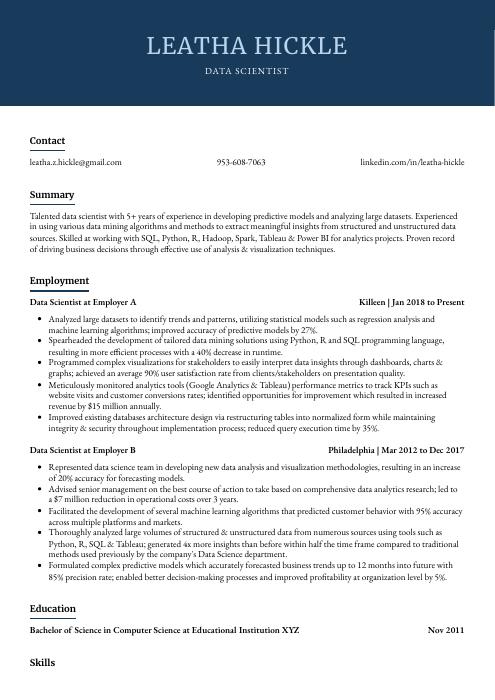 Bonobo
Bonobo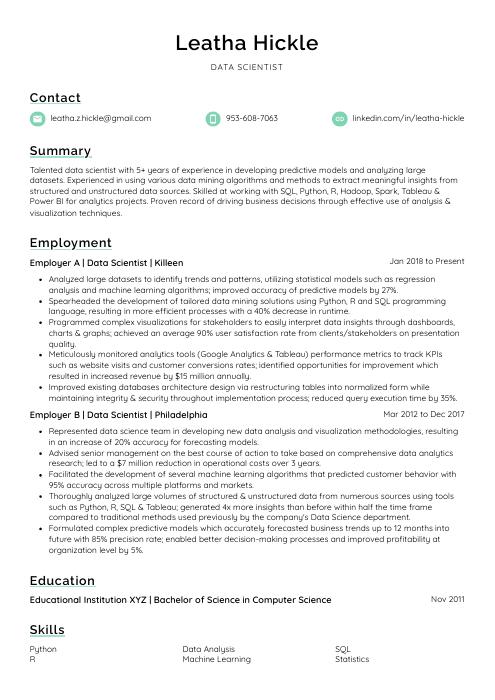 Lorikeet
Lorikeet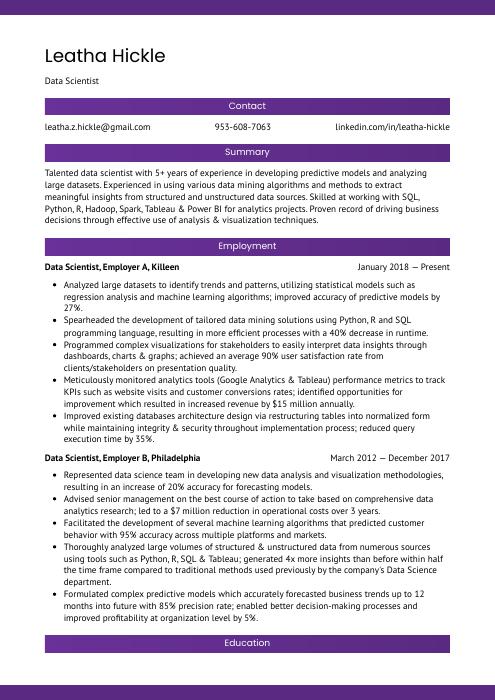 Jerboa
Jerboa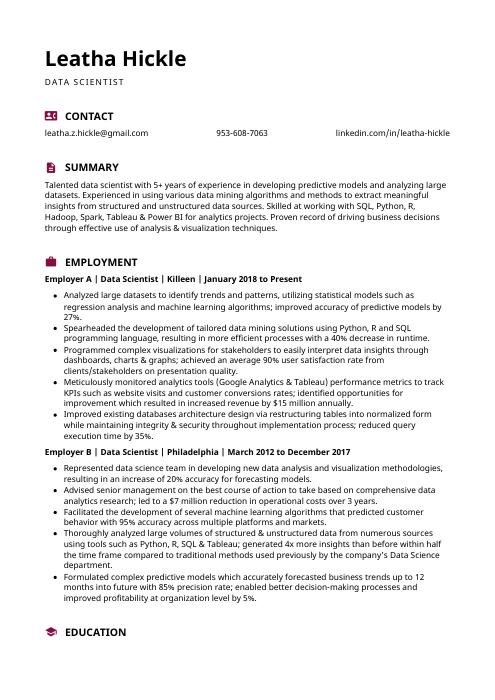 Hoopoe
Hoopoe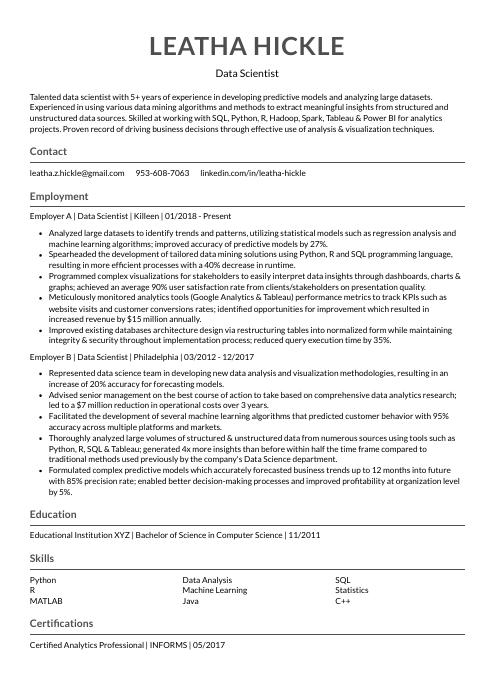 Indri
Indri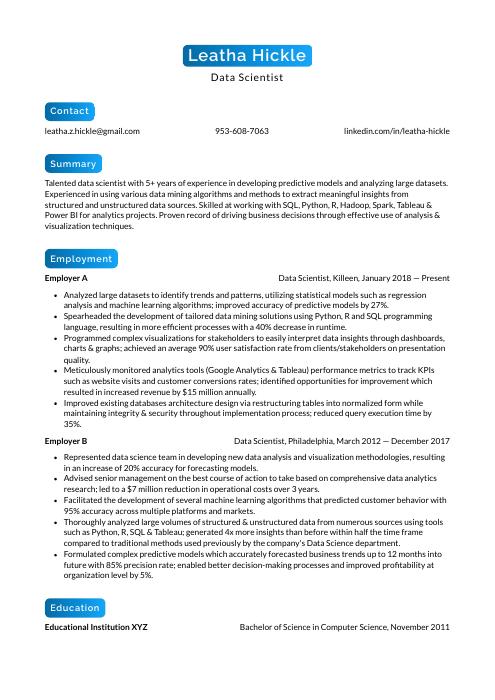 Kinkajou
Kinkajou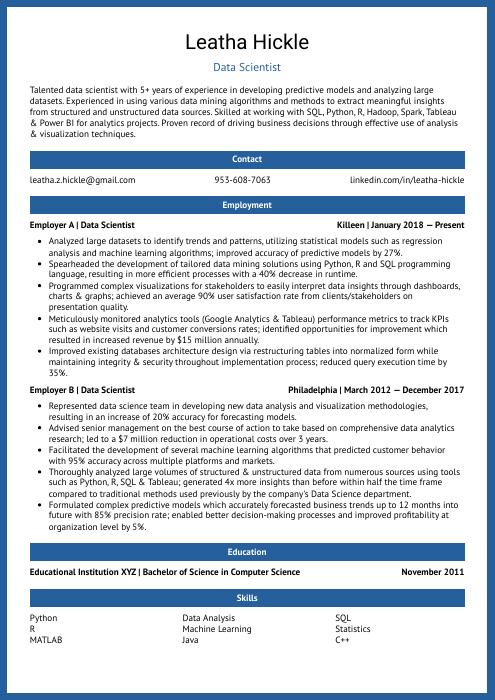 Ocelot
Ocelot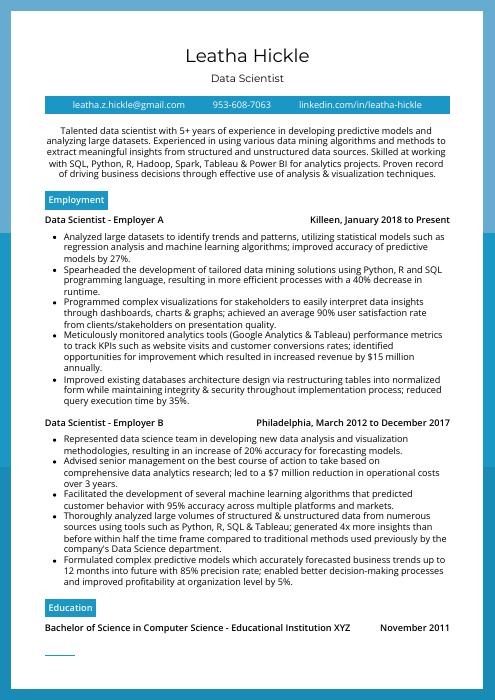 Rhea
Rhea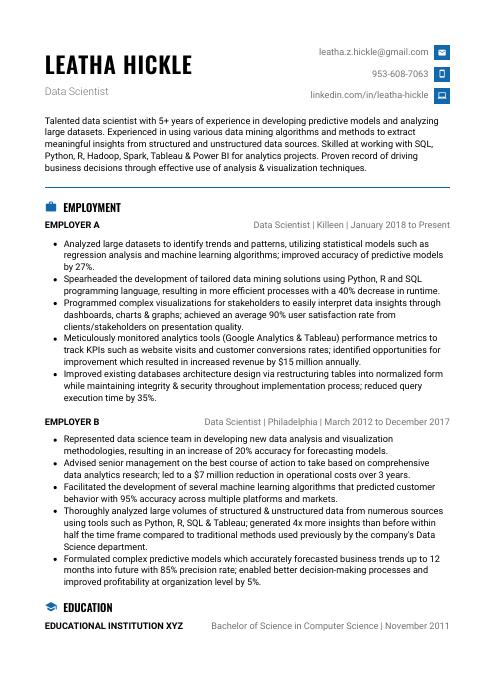 Echidna
Echidna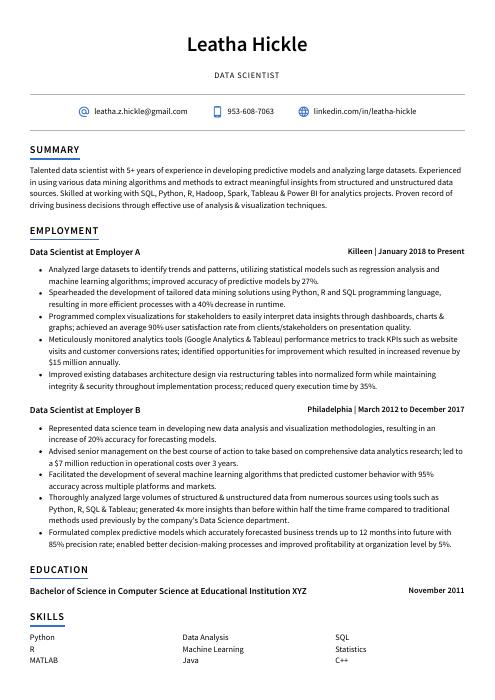 Axolotl
Axolotl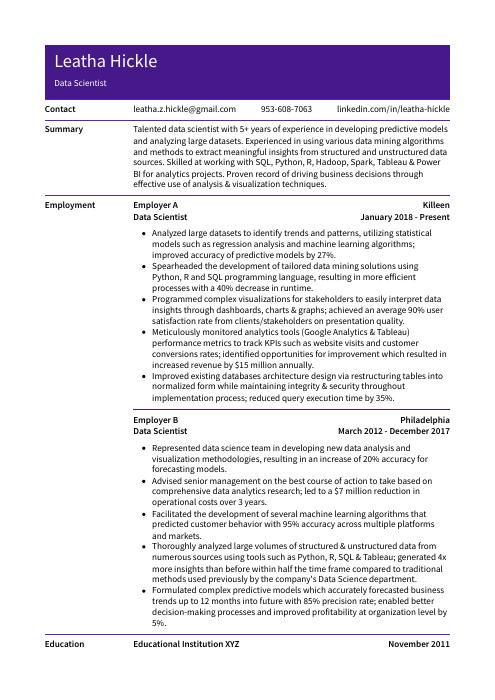 Pika
Pika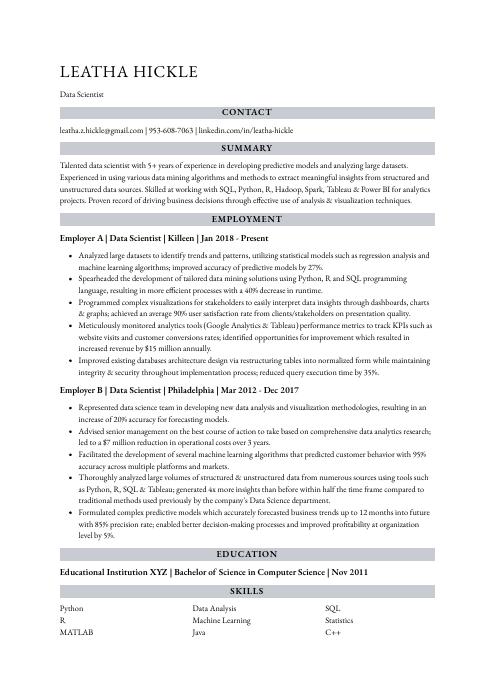 Numbat
Numbat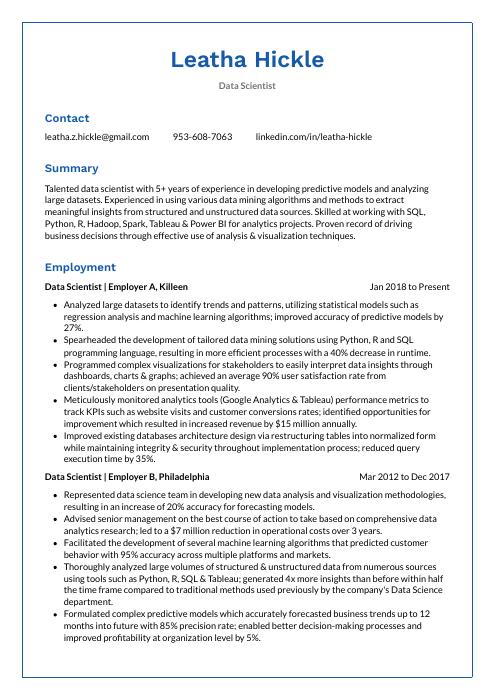 Markhor
Markhor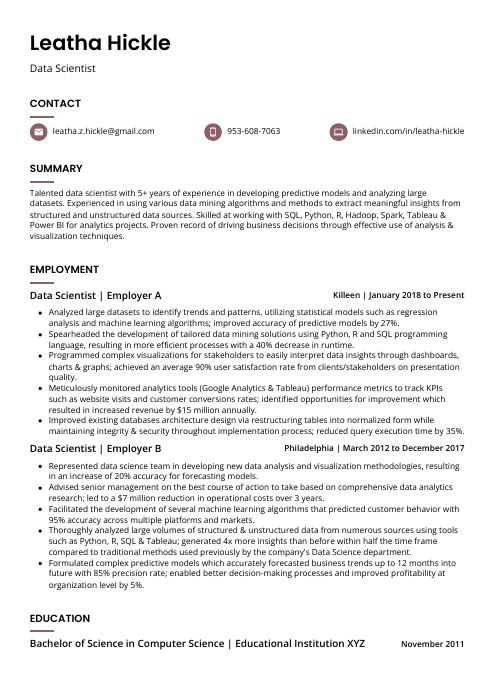 Fossa
Fossa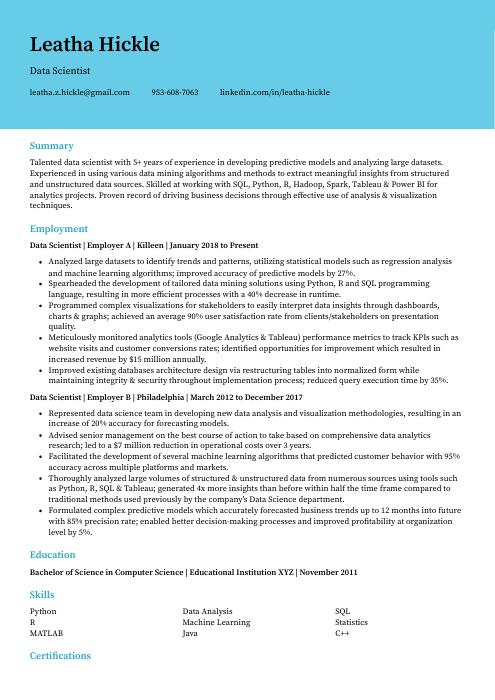 Dugong
Dugong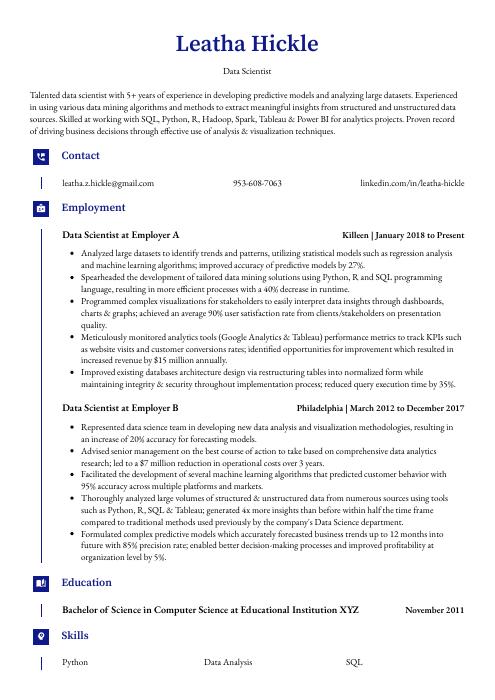 Gharial
Gharial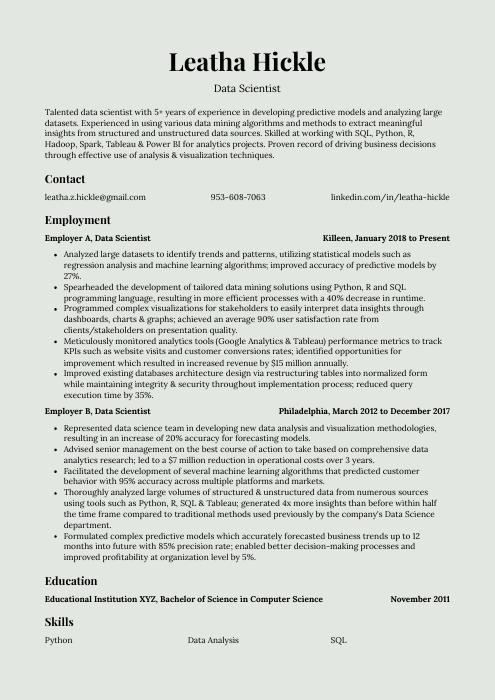 Saola
Saola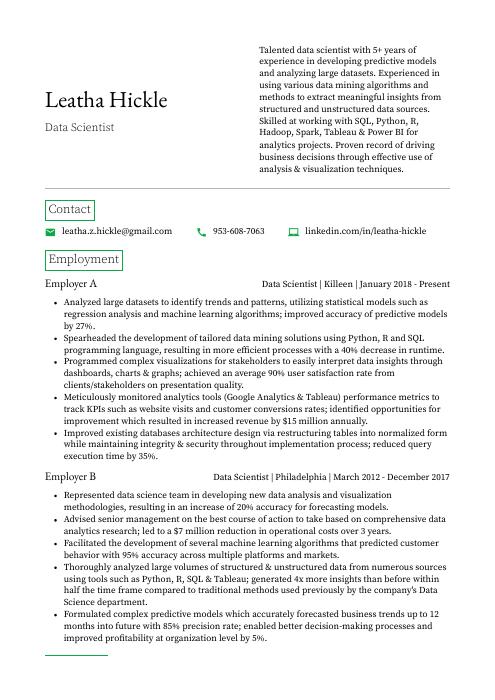 Quokka
Quokka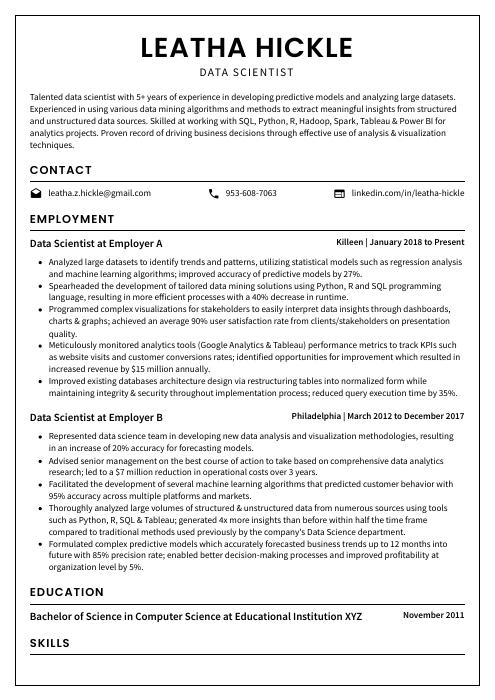 Cormorant
Cormorant Rezjumei
Rezjumei
